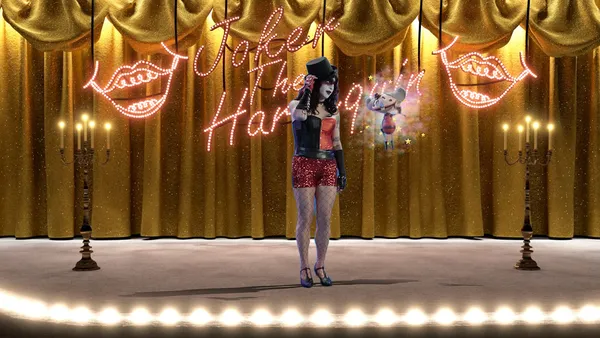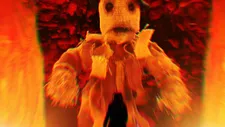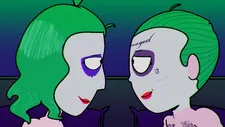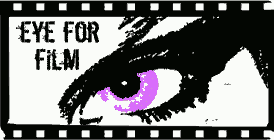 |
| Vera Drew as Joker the Harlequin and Ember Knight as Mx Mxyzptlk in The People's Joker. Photo: courtesy of Matchbox Cine |
I was fortunate enough to see The People’s Joker fairly early on its initial run, intrigued by the concept but not expecting it to go very far as a low budget indie creation with niche themes and outsider humour. Now that it’s finally on its way to UK cinemas, it has won over a dozen awards from major festivals and awards bodies including the OFCS and, appropriately enough, the Gothams. It has been hailed as an antidote to Tod Phillips’ vision, though its creator is actually a fan of that. It’s certainly the antithesis of the Gotham universe as understood by terminally online toxic Batman obsessives, but not because it’s picking a fight – rather because it finds a lot of colour in the shadows. Combining DC Comics mythology with a semi-autobiographical tale of gender transition and self discovery, it’s wildly creative and anarchic in a way the Joker would be proud of.
It’s the creation of Vera Drew, who also stars in it as a young comedian trying to make her way in the big city after escaping an unhappy home life and conversion therapy as practised by one Dr. Crane. Eventually taking on the name Joker the Harlequin, and dating a mysterious green-haired Mr. J, Vera’s character hangs out with the Penguin, Poison Ivy and Clayface, and explores Gotham City is a distinctly queer way. It wasn’t something that Vera ever expected to get awards for.
 |
| Vera Drew as Scarecrow in The People's Joker. Photo: courtesy of Matchbox Cine |
“That was not on my radar at all while we were making it,” she tells me when we meet. “I mean, maybe in my wildest dreams, but even then it would have just felt like a joke or something, the idea of this movie getting nominated for anything or me getting nominated for anything. But I'll take it. It's nice.”
It's really amazing that the film got to this stage to begin with, given the copyright issues involved. Not that the Joker would have any patience with that kind of thing.
“Thankfully now I can talk about that stuff a little bit more than I've been able to in the past,” she says. “I think Warner Brothers was really focused on protecting the integrity of their Joker sequel and making sure our release didn't confuse the market at all, which was always funny to me, just because the audiences for our movies are, I feel, very different. I mean, I loved Joker too. I'm, like, one of four people that loved it. But at the same time, I kind of understand where they're coming from.
“It was a really long road from our first première at the Toronto International Film Festival in 2022 to right now, in this moment. I think it's what makes the kind of response that it's gotten and continues to get feel all the more surreal, just because there were so many moments throughout the course of the journey where I was pretty sure the movie was never going to see the light of day again. But I was thankfully surrounded by friends, and a few lawyers, who were all pretty encouraging. They felt that what we had done totally did fall under parody law.
“I really did go out of my way to try to follow the precedents that I could follow for what counts as parody. So I think in my clearest moments, I always knew it would get out there at some point. It was just a matter of when and how. And, yeah, thank God for people like Sean and Megan at Matchbox City who really stood by my side and kind of believed in the spirit of what we were doing.”
Her film feels very much in the spirit of the comics, but the Joker is a big enough character to allow for both those very different interpretations. Was it always about the Joker for her?
“I think so. I think because of just how flexible of a character it is. I like that the mythology is so fragmented, and it's like something you can't really quite put your finger on. The anarchist chaos of it all is super interesting to explore. I think a lot of times, anarchy and chaos is glamourised in a way, but the fact that it's applied to this character that is usually a murdering, mentally ill clown is like, I don't know. It's like peanut butter and jelly. It just goes well together for me in a way that kind of makes sense.
“In making it a trans story, it's always felt like a queer character to me. Especially the way somebody like Grant Morrison wrote about the Joker in their Arkham Asylum graphic novel. You know, Joker in that is basically a drag queen. I know Grant pitched the character as like a drag queen, and Warner Brothers wasn't for it. But there's always been this queer subtext to the character in the comics and stuff. So I liked the idea of making something where there was no subtext. It was just all context and all surface level. This is the gayest and most trans version of all of these characters you'll ever see. It was just so satisfying to do as somebody that has been into these characters for most of my life at this point.”
I tell her that it feels to me like a healthy thing to do, when cinema is exploring more and more trans narratives – to break away from the idea that trans characters have to be straightforward good people so that they don't upset anybody and so that filmmakers can talk about issues rather than characters. By bringing out these characters in this way, she has room to talk about trans people as actual individuals and human beings, even though this is comic book territory.
 |
| Vera Drew as Joker the Harlequin and Kane Distler as Mr. J in The People's Joker Photo: courtesy of Matchbox Cine |
“Yeah,” she says enthusiastically. “I mean, for me, I don't want to watch any movie where a character doesn't change or grow. I think what's inherently the problem with a lot of representation – it ends up being in service. I think there's good intentions to it sometimes, but I've never loved the ‘Look at gay people, look at trans people. They're just like us!’ type of representation, even removing morality from it. It's trying to create this monolith of identity experience. It just doesn't work for me because that's just not how it is.
“Gay marriage is very different than straight marriage, you know? T4T relationships, between two trans people, are very different than relationships that are between cis people, or a relationship between a cis person and a trans person. Even in a movie like this, where it's so ridiculous and goofy and we're breaking the fourth wall a lot, it's just so much more emotionally grounded and relatable to come at a certain story with the understanding that experiences are unique and specific in queer life. I think that specificity ends up actually being what makes it relatable even to cis people and straight people. It's just a more authentic way of telling a story.”
I suggest that perhaps it's about what people notice as well. Dr. Crane’s drug, the sinister Smilex, speaks to a theme where so much of life is about how people are supposed to behave to keep others calm and content rather than to be themselves. Maybe cishet people don't notice that as much.
“Yeah. And also it was funny because the Smilex idea came originally from a real body horror thing. I was processing what I call ‘irony poisoning’, just being so detached from reality at a certain point in my life where everything was just a joke to me, and that came from a dissociation, growing up and being told ‘Don't talk about how you're feeling. Just get your work done and be a good kid.’ So I was coming at it from this very on-the-nose body horror place.
“The original idea for the movie, before it was even a Joker movie, was about a trans woman who was kind of realising she was trans while doing drag, and was physically and literally addicted to irony. Like in this kind of like Cronenberg way where it was consuming her or something. Then when I started writing the script for this with Bri LeRose, my co-writer, she brought up the way that women are always told to smile. I was like, ‘Oh, I hadn't even thought of that.’ That wasn't even on my radar as a thing. I think my experience with that has been more like I'm always forcing a smile. I'm very autistic, so I had to teach myself how to make facial expressions in a mirror when I was a kid. But I think there were a lot of different layers just to that. It's a useful metaphor that really resonated with a lot of us as we were making it.
“In the beginning when I started making the movie, one of my legal defences for it was just that we are told all the time that these are modern myths, and myth theoretically should belong to the people. It's a working class tradition. It's not like billionaires who control, like, I mean, I guess the Vatican, but historically it's about coming of age and understanding the common person's relationship to their place in society. I don't really know that I actually fully believed that, so we were in the middle of working on it and just seeing how each individual artist and actor had a very specific, unique relationship with each and every one of these characters. It made fleshing out this dense and vivid story all the easier, because everybody was bringing their own perspective to it.”
The Joker seems like a natural place to explore the intersection of comedy and horror and the way that when things just become overwhelming in life, laughter is a way of handling that.
 |
| Vera Drew as Joker the Harlequin in The People's Joker. Photo: courtesy of Matchbox Cine |
“Yeah. And I also think the Joker is a character that's supposed to be annoying. My favourite Joker is probably Cesar Romero, because he's kind of like a joker but he's also like a pirate. I think the Joker is supposed to be a little swashbuckling. There's just nothing more annoying than pirates to me, and I think that's an essential element. And it was something else that just felt very specific, I think. So much transphobia and homophobia and just the unpleasant interactions that queer people have comes from a place of two people just being annoyed with each other and just kind of, like, ‘What? I don't understand what you're saying. What are these? What's a pronoun? What are you going for with this look?’ It just seemed like this perfect, loud representation of that.
“There's this line in the movie, after Joker the Harlequin dives into a vat of oestrogen and really starts getting fully Jokerfied. She's talking about how she's playing with her wardrobe and her gender expression and trying on make-up and stuff, and how scary it is. But if she's wearing clown make-up, people just don't bother her. They’re cool with clowns, but not with trans people. Even now, when I go and do appearances and stuff, and we're screening the movie, I always wear clown make-up because it's such a buffer to immediately have up.
“I've gone through various phases in my transition and where I'm dressing the loudest and the most extreme and the most, like, look-at-me, it’s usually when I'm feeling very small and kind of want to hide. Because I think when people stare at you in clown make-up, you generally know why they're staring at you. It's not because you're a clockable trans woman.”
Coming up: Vera Drew on the Penguin, autobiographical elements in the film, bringing together different artistic styles, and an unexpected wedding.
The People's Joker will be in cinemas across the UK from Friday 21 February. It's currently screening in Iowa City and will be in Tempe, AZ from 14 March.
























